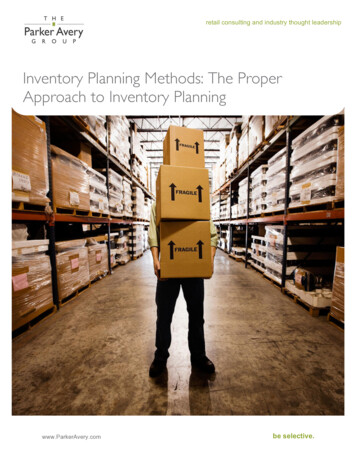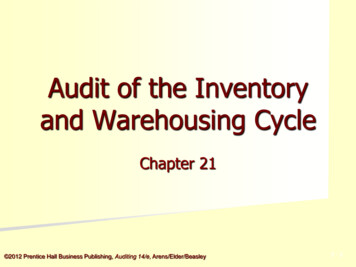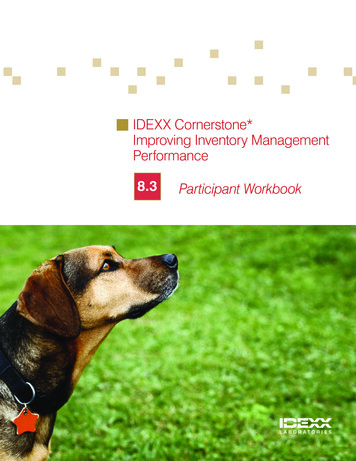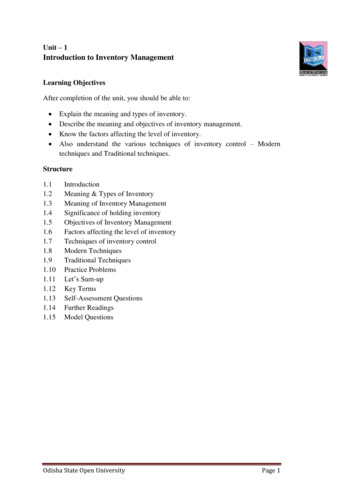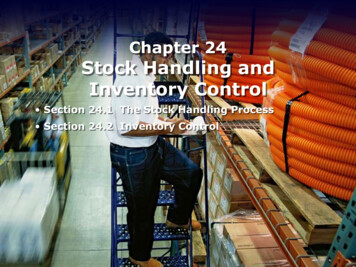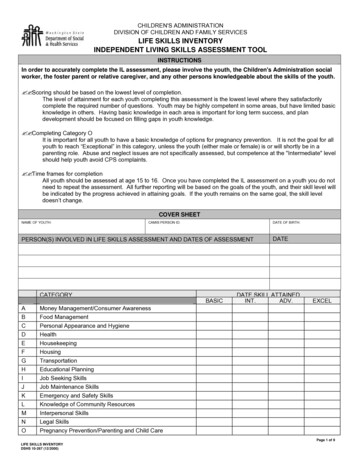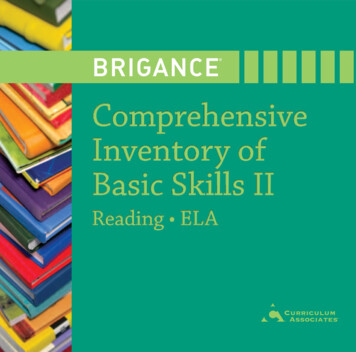
Transcription
ComprehensiveInventory ofBasic Skills IIReading ELA
TABLE OF view.8BRIGANCE Special Education System.9Program Decisions.10Step-by-Step Assessment ProceduresStep 1: Get Ready for the Assessment.11Step 2: Conduct the Assessment.14Step 3: Record Results in the Student Record Book.16Step 4: Analyze Results.18Step 5: Identify Next Steps.20Evaluating Students with Special ConsiderationsBilingual and Non-English-Speaking Students.21Students with Exceptionalities.21PageM MATHEMATICS GRADE PLACEMENT .380N NUMBER AND OPERATIONS .394O ALGEBRA . .485PGEOMETRY .538Q MEASUREMENT .589R DATA ANALYSIS AND PROBABILITY .646REPRODUCIBLES.712APPENDICESAppendix A—History and Acknowledgments . .727Appendix B—References .728A READINESS . .27B SPEECH .103C LISTENING .119EORAL READING . .155FREADING COMPREHENSION—SHORT PASSAGES .168G READING COMPREHENSION—LONG PASSAGES .203H WORD ANALYSIS .227IFUNCTIONAL WORD RECOGNITION . .275JSPELLING .302K WRITING . .320L3RESPONDING TO WRITING PROMPTS .354BRIGANCE CIBS IITable of Contents BRIGANCE CIBS II Curriculum Associates LLC www.CurriculumAssociates.com 800-225-0248Table of ContentsD WORD RECOGNITION GRADE PLACEMENT .149
TABLE OF ersonal Data Response.29A-2Recognizes Colors.32A-3Self-help Skills.34A-4Draws a Person.36A-5Visual Motor Skills—Forms .38A-6Visual Discrimination—Forms, Letters, and Words .40A-7Identifies Body Parts .42A-8Recites Alphabet.43A-9Reads Uppercase Letters . .44A-10Reads Lowercase Letters . .45A-11Prints Uppercase Letters in Sequence.46A-12Prints Lowercase Letters in Sequence.47A-13Prints Uppercase Letters Dictated.48A-14Prints Lowercase Letters Dictated.49A-15Prints Personal Data.50A-16Counting.52A-17Understands Quantitative Concepts .53A-18Counts Objects.56A-19Reads Numerals.57A-20Joins Sets.58A-21Numeral Comprehension .61A-22Writes Numerals in Sequence.62A-23Standing Gross-Motor Skills .63A-24Walking Gross-Motor Skills.65A-25Running and Skipping Gross-Motor Skills.67A-26Understands Directional and Positional Concepts.69A-27Readiness for Reading.72A-28Knows Common Signs.74A-29Oral Expression.76A-30Articulation—Initial Sounds of Words.79A-31Articulation—Final Sounds of Words.844A-32A-33A-34PageAuditory DiscriminationForm A.87Form B.89Identifies Initial Consonants in Spoken Words.91Sounds of Letters.93Supplemental and Related Lists/Skill Sequences.95Comprehensive Skill Sequences.101BSpeech . .103AssessmentsB-1General Speech and Language Development.105B-2Responds to a PictureForm A (Urban Scene).110Form B (Suburban Scene) .113B-3Speech Observations Checklist.116Comprehensive Skill Sequence.118CListening.119AssessmentsC-1Sentence Memory.121C-2Follows Oral Directions.123C-3 Listening Vocabulary Comprehension Grade-Placement TestForm A.126Form B.130Assessments—Listens and ComprehendsC-4Listening Comprehension Grade-Placement Test .132C-4a Lower First-Grade Level (Forms A & B).134C-4b Upper First-Grade Level (Forms A & B).135C-4c Lower Second-Grade Level (Forms A & B).136BRIGANCE CIBS IITable of Contents BRIGANCE CIBS II Curriculum Associates LLC www.CurriculumAssociates.com 800-225-0248Table of ContentsPage
PageD Word Recognition Grade Placement.149AssessmentsD-1Word Recognition Grade-Placement TestForm A.150Form B.153E Oral Reading.155Assessments—Reads OrallyE-1a & b Preprimer orPrimer Level (Forms A & B).160E-1c & d Lower First-Grade orUpper First-Grade Level (Forms A & B).161E-1e & f Lower Second-Grade orUpper Second-Grade Level (Forms A & B).162E-1g & h Lower Third-Grade orUpper Third-Grade Level (Forms A & B).163E-1i & jFourth-Grade orFifth-Grade Level (Forms A & B).164E-1k & l Sixth-Grade orSeventh-Grade Level (Forms A & B).165E-1m & n Eighth-Grade orNinth-Grade Level (Forms A & B).1665FReading Comprehension—Short Passages.168Assessment—Grade-Placement TestF-1Reading Vocabulary Comprehension Grade-Placement TestForm A.173Form B.176Assessments—Comprehends PassagesF-2aPrimer Level Forms A & B.179F-2bLower First-Grade Level Forms A & B.180F-2cUpper First-Grade Level Forms A & B.181F-2dLower Second-Grade LevelForm A.182Form B.183F-2eUpper Second-Grade LevelForm A.184Form B.185F-2fLower Third-Grade LevelForm A.186Form B.187F-2gUpper Third-Grade LevelForm A.188Form B.189F-2hFourth-Grade LevelForm A.190Form B.191F-2iFifth-Grade LevelForm A.192Form B.193F-2jSixth-Grade LevelForm A.194Form B.195F-2kSeventh-Grade LevelForm A.196Form B.197F-2lEighth-Grade LevelForm A.198Form B.199F-2m Ninth-Grade LevelForm A.200Form B.201BRIGANCE CIBS IITable of Contents BRIGANCE CIBS II Curriculum Associates LLC www.CurriculumAssociates.com 800-225-0248Table of ContentsAssessments—Listens and ComprehendsC-4d Upper Second-Grade Level (Forms A & B).137C-4e Lower Third-Grade Level (Forms A & B).138C-4f Upper Third-Grade Level (Forms A & B).139C-4g Fourth-Grade Level (Forms A & B).140C-4h Fifth-Grade Level (Forms A & B).141C-4i Sixth-Grade Level (Forms A & B).142C-4j Seventh-Grade Level (Forms A & B).143C-4k Eighth-Grade Level (Forms A & B).144C-4l Ninth-Grade Level (Forms A & B).145C-5 Listening Observations Checklist .146Page
PagePageReading Comprehension—Long Passages.203H Word Analysis.227Assessments—Comprehends PassagesG-1a First-Grade LevelForm A.208Form B.209G-1b Second-Grade LevelForm A.210Form B.211G-1c Third-Grade LevelForm A.212Form B.213G-1d Fourth-Grade LevelForm A.214Form B.215G-1e Fifth-Grade LevelForm A.216Form B.217G-1f Sixth-Grade LevelForm A.218Form B.219G-1g Seventh-Grade LevelForm A.220Form B.221G-1h Eighth-Grade LevelForm A.222Form B.223G-1i Ninth-Grade LevelForm A.224Form B.225AssessmentsH-1Word Analysis SurveyForm A.229Form B.233H-2Substitutes Initial-Consonant Sounds.236H-3Substitutes Short-Vowel Sounds.240H-4Substitutes Long-Vowel Sounds.243H-5Substitutes Final-Consonant Sounds.246H-6Substitutes Initial-Blend and Initial-Digraph Sounds.251H-7Reads Words with Common Endings.256H-8Reads Words with Vowel Digraphs and Diphthongs.259H-9Reads Words with Phonetic Irregularities.262H-10 Reads Suffixes.265H-11 Reads Prefixes.268H-12 Divides Words into Syllables.2696Supplemental and Related Lists/Skill Sequences.271I Functional Word Recognition.275AssessmentsI-1Basic Sight Vocabulary.278I-2Direction Words.282I-3Number Words.285I-4Warning and Safety Signs.288I-5Informational Signs.290I-6Warning Labels.293I-7Food Labels.296Supplemental Lists/Skill Sequences.298BRIGANCE CIBS IITable of Contents BRIGANCE CIBS II Curriculum Associates LLC www.CurriculumAssociates.com 800-225-0248Table of ContentsG
PageSpelling.302AssessmentsJ-1 Spelling Grade-Placement TestForm A.304Form B.306J-2 Spells Initial Consonants of Spoken Words.307J-3 Spells Initial Blends and Digraphs of Spoken Words.308J-4 Spells Suffixes.311J-5 Uses Suffixes in WritingForm A.313Form B .314J-6 Spells Prefixes.315J-7 Spells Number Words.318Supplemental Lists/Skill Sequences.319K Writing.320AssessmentsK-1Writes Cursive Lowercase Letters in Sequence.322K-2Writes Cursive Uppercase Letters in Sequence.323K-3Quality of Writing—Manuscript and Cursive.325Criteria and Samples—Manuscript.326Criteria and Samples—Cursive.327K-4Writes Personal Data.328K-5CapitalizationLevel I (3rd grade and below) .331Level II (4th grade and above) .334K-6PunctuationLevel I (4th grade and below) . .337Level II (5th grade and above) .340K-7Addresses Envelope.343K-8Writes Personal Letter.346K-9Writes Letter Requesting Information or Material.349K-10 Writes Customer-Complaint Letter.3527LResponding to writing Prompts.354Assessments—Responds to Writing PromptsL-1a Grades 1 and 2—Personal Narrative.355L-1b Grades 1 and 2—Descriptive Writing.356L-1c Grades 1 and 2—Expository Writing.357L-1d Grades 1 and 2—Fictional Narrative.358L-2a Grades 3–5—Personal Narrative.359L-2b Grades 3–5—Fictional Narrative.360L-2c Grades 3–5—Expository Writing.361L-2d Grades 3–5—Friendly Letter.362L-3a Grades 6–8—Personal Narrative.363L-3b Grades 6–8—Fictional Narrative.364L-3c Grades 6–8—Expository Essay.365L-3d Grades 6–8—Persuasive Essay.366Scoring Rubric, 4-point—Grades 1 and 2.367Scoring Rubric, 6-point—Grades 1 and 2.368Scoring Rubric, 4-point—Grades 3–8.369Scoring Rubric, 6-point—Grades 3–8.370BRIGANCE CIBS IITable of Contents BRIGANCE CIBS II Curriculum Associates LLC www.CurriculumAssociates.com 800-225-0248Table of ContentsJPage
IntroductionThe BRIGANCE Comprehensive Inventory of Basic Skills II, or CIBS II, is acomprehensive collection of valid, reliable, and well-researched reading, ELA,and math assessments for students with special needs in grades K-9.The CIBS II consists of two content-specific volumes—CIBS II Reading/ELAand CIBS II Mathematics—that offer a complete range of informationon students’ academic skill levels, as demonstrated under real-life,everyday conditions.The CIBS II is designed to meet the requirements of programs serving studentswith special needs. The curriculum-based assessments and grade-levelplacement tests in the CIBS II allow teachers to accurately pinpoint a student’spresent level of achievement. Teachers can then identify a sequence ofobjectives for planning grade-appropriate instruction, for writing IEPs, and forindividualizing ongoing assessment and progress monitoring.CIBS II Reading/ELA includes reading and writing assessments for grades K–9as well as grade-placement tests for grades 1–9. The assessments in theReadiness section can be used to determine kindergarten or first-gradereadiness and to measure progress throughout the first critical years. TheInventory’s key reading and ELA skill areas, listed below, correlate tocommonly tested skills and strategies that reflect state standards. Word Analysis Readiness Speech Functional Word Recognition Listening Spelling Oral Reading Writing Reading Comprehension— Responding to Writing PromptsShort and Long PassagesCIBS II Mathematics contains grade-level placement tests for grades K–8 aswell as a wealth of math assessments organized by the NCTM Standards. Number and Operations Algebra Geometry Measurement Data Analysis and Probability8The mathematics skills, which represent typical grade-level assignments formost state standards, are organized within each section by grades K–2,grades 3–5, and grades 6–8.The following key features of the CIBS II facilitate identifying steps for skillmastery and instructional planning. The Record Book provides a record-keeping and tracking system that isongoing, specific, graphic, and easily interpreted. Supplemental and Related Lists/Skill Sequences provide additional skills toillustrate progress. Assessments provide prewritten IEP objective statements. Readiness assessments are correlated to the BRIGANCEReadiness Activities.The CIBS II helps special education teachers and program directors to: meet inclusion goals by determining present level of academicachievement and functional performance (PLAAFP), areas of strengthand need, and instructional objectives; communicate student progress and instructional objectives to parents; provide an appropriate assessment system that aligns with theircurriculum and provides a means for gathering data on thestudents’ progress; track and report individual and group progress online atwww.BRIGANCE.com (annual subscription rates apply); support a referral for further evaluation or for special services or toconfirm a diagnosis; assess school readiness by tapping predictors of school success.Although primarily used as a criterion-referenced measure, key developmentalassessments in the Comprehensive Inventory of Basic Skills II have also beennewly standardized and validated on children ages five to thirteen. If you wishto derive quotients, percentiles, and grade and age-equivalents, see the CIBS IIStandardized and the accompanying Standardized Record Book available fromCurriculum Associates, Inc. To learn more about the standardization of theComprehensive Inventory of Basic Skills II, see Chapters 6–8 of the CIBS IIStandardization and Validation Manual.BRIGANCE CIBS IIOverview BRIGANCE CIBS II Curriculum Associates LLC www.CurriculumAssociates.com 800-225-0248IntroductionOverview
The assessments in the CIBS II Reading/ELA are organized by the followingreading/ELA skills, which are reflected in state standards. Readiness Word Analysis Speech Functional Word Recognition Listening Spelling Oral Reading Writing Reading Comprehension— Responding to WritingShort and Long PassagesPromptsThe assessments in the CIBS II Mathematics are organized by the NCTMStandards. Number and Operations Measurement Algebra Data Analysis and Probability GeometryThe complete BRIGANCE Special Education System includes:1. Inventory of Early Development II (IED II)The IED II is ideal for providing ongoingassessment and instructional planning for studentsup to developmental age 7. The assessments inthe IED II allow easy monitoring of individualprogress and supports the development of eachstudent’s IEP.Inventoryof EarlyDevelopment IIComprehensiveInventory ofBasic Skills IIThe assessments in the CIBS II are organizedinto two volumes: CIBS II Reading/ELA andCIBS II Mathematics. These new editions(2010 copyright) incorporate a broad set ofassessments in key academic skill areas reflectedin state and national standards.Reading ELAComprehensiveInventory ofBasic Skills IIMathematics4. CIBS II StandardizedReading, writing, and mathematics standardizedassessments are combined in one convenientinventory for easy administration. The CIBS IIStandardization and Validation Manual includesdemographic information on 2010restandardization and updated tables.ComprehensiveInventory ofBasic Skills IIStandardized5. Transition Skills Inventory (TSI)With comprehensive assessments focused onpost-secondary education, employment,independent living, and community participationskills, the new TSI supports IEP writing andprogress monitoring for middle- and high-schoolstudents and makes it easy to address IDEArequirements for transition planning.6. BRIGANCE OnlineManagement SystemTransition SkillsInventoryCalvin BaldwinInventoryof EarlyDevelopment IIStandardizedUse the online management systemto generate student and class reportsin real time to see progress andcraft instructional plans.Visit www.BRIGANCE.com.IRecord BookIObservations0000004IReportsIFamily ConnectionIBirth DateClass06/10/1999MasonChange InventoryChoose an InventoryHow Do I.Inventory of Early Development IIEnter a New StudentEnter a new studentEnter Inventory DataEnter Inventory Data for astudentComprehensive Inventory of Basic Skills II Standardized assessments from the IED II arecombined in one inventory for ease of use.Validation information is included in the IED IIStandardization and Validation Manual.Student IDedit student informationStudent Status2. IED II StandardizedMy Students I Group Reports I IEP Resources I My Account I Help I LogoutWelcome Pauline MasonBRIGANCE Management SystemTransition Skills InventoryCreate a ReportCreate a Report with astudent’s dataSend a Home LetterSend or Print a Home letter7. CA101Free online training is available 24/7 at www.BRIGANCE.com.9BRIGANCE CIBS II BRIGANCE Special Education SystemBRIGANCE CIBS II Curriculum Associates LLC www.CurriculumAssociates.com 800-225-0248IntroductionThe BRIGANCE Comprehensive Inventory of Basic Skills II is a component ofthe overall BRIGANCE Special Education System developed to help specialeducators determine a student’s present level of academic achievement andfunctional performance (PLAAFP), administer targeted ongoing assessment,measure progress, and plan instruction.3. Comprehensive Inventory ofBasic Skills II (CIBS II)❮BRIGANCE Special Education System
Program DecisionsAs explained below, the CIBS II is an invaluable resource for elementary andmiddle-school programs responsible for complying with these requirements.DETERMINE PRESENT LEVEL OF ACADEMIC ACHIEVEMENTThe CIBS II is a comprehensive inventory of grade-placement tests, andreading/ELA and math assessments, ideal for identifying presentlevel of academic achievement.Many assessment items include grade-level notations to pinpoint the levelat which an assessment should begin.PROVIDE INSTRUCTIONAL OBJECTIVES FOR AN ONGOING IEPThe major component of most IEPs is the identification of instructional objectivesthat meet the needs of the student. The four requirements of the typicalobjective are the date of the next assessment, the methods of assessment, thepresent level of achievement, and the objectives to be achieved.The CIBS II and the accompanying Record Book meet the requirements ofcompliance as shown below.10RequirementHow the Requirement Is Met1. Date of nextassessmentThe date of the next assessment is recorded in the Datecolumn in the Record Book (RB).2. Methods ofassessmentComprehensive Inventory of Basic Skills II is used forassessing.3. Present level ofachievementSkills of the highest level achieved in the skill sequenceare circled in the RB during the assessment.4. Objectives to beachievedObjectives are identified by underlining in the RB theskills to be achieved, using a pen of the designated color.BRIGANCE CIBS II Each assessment in the CIBS II provides a prewritten IEP objective statement. Ifinstructional objectives are required on locally developed forms, the objecti
5 BRIGANCE CIBS II Table of Contents Table of Contents Page F READING COMPREHENSION—SHORT PASSAGES.168 Assessment—Grade-Placement Test F-1 Reading Vocab

